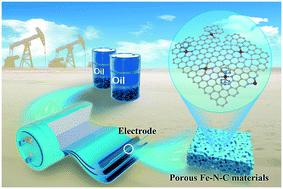当前位置:
X-MOL 学术
›
Environ. Sci.: Nano
›
论文详情
Our official English website, www.x-mol.net, welcomes your
feedback! (Note: you will need to create a separate account there.)
In situ controlled synthesis of porous Fe–N–C materials from oily sludge by chlorinating calcination and their novel application in supercapacitors
Environmental Science: Nano ( IF 5.8 ) Pub Date : 2020-10-19 , DOI: 10.1039/d0en00892c Hanfeng Zhou 1, 2, 3, 4, 5 , Zhibo Deng 1, 2, 3, 4, 5 , Tianbao Liu 1, 2, 3, 4, 5 , Tao Liu 1, 2, 3, 4, 5 , Lijuan Zhang 1, 2, 3, 4, 5 , Xintai Su 1, 2, 3, 4, 5 , Zhang Lin 1, 2, 3, 4, 5
Environmental Science: Nano ( IF 5.8 ) Pub Date : 2020-10-19 , DOI: 10.1039/d0en00892c Hanfeng Zhou 1, 2, 3, 4, 5 , Zhibo Deng 1, 2, 3, 4, 5 , Tianbao Liu 1, 2, 3, 4, 5 , Tao Liu 1, 2, 3, 4, 5 , Lijuan Zhang 1, 2, 3, 4, 5 , Xintai Su 1, 2, 3, 4, 5 , Zhang Lin 1, 2, 3, 4, 5
Affiliation

|
The science linking thermochemical conversion of large-scale industry oily sludge with applied materials has been improved in the last ten years. However, with the traditional converting methods it is hard to precisely control the composition and structure of oily sludge-based products during pyrolysis due to the complexity of the composition of the oily sludge. Here, a chlorinating calcination method using sodium chloride (NaCl) as a chlorinating salt and template was first developed to prepare porous Fe–N–C materials (FCN-500) through pyrolysis of oily sludge containing iron-bearing minerals and pyridine. The formation mechanism of FCN-500 was proposed, where iron ions (Fe3+) from the inorganic component (anorthite) in the sludge were rapidly dissociated with the assistance of NaCl, followed by coordination with the organic component (pyridine nitrogen) in the oily sludge to form the pyridine nitrogen–iron ((C5H6N)n–Fe) complex, and then carbonization. As-obtained FCN-500 exhibited higher specific capacitance (286.3 F g−1 at a current density of 0.5 A g−1), enhanced energy density (33.5 W h kg−1 at a power density of 606.1 W kg−1) and more excellent stability and durability (more than 80.1% capacitance retention after 10 000 cycles) compared with two other electrodes. The reasonably better performance of the obtained FCN-500 in supercapacitors (SCs) is attributed to its large surface area, hierarchically porous channels, high conductivity, and unique Fe–N–C structure. Therefore, this work not only provides a feasible way to solve the bottleneck problem in sludge pyrolysis, but also provides a method to design large scale porous Fe–N–C materials for practical applications.
中文翻译:

含氯污泥原位控制合成法制备含油污泥中的多孔Fe-N-C材料及其在超级电容器中的新应用
在过去的十年中,将大型工业含油污泥的热化学转化与应用材料联系起来的科学得到了改进。但是,在传统的转化方法中,由于油泥组成的复杂性,在热解过程中很难精确地控制油泥基产品的组成和结构。在这里,首先开发了一种使用氯化钠(NaCl)作为氯化盐和模板的氯化煅烧方法,以通过热解含铁矿物和吡啶的含油污泥制备多孔的Fe–N–C材料(FCN-500)。提出了FCN-500的形成机理,其中铁离子(Fe 3+)从污泥中的无机成分(钙长石)中被氯化钠迅速分解,然后与油性污泥中的有机成分(吡啶氮)配位形成吡啶氮铁((C 5 H 6 N)n –Fe)络合物,然后碳化。作为得到的FCN-500(286.3 F G表现出较高的比电容-1在0.5 A g的电流密度-1),增强的能量密度(33.5 W时千克-1在606.1千克w ^的功率密度-1),并且与其他两个电极相比,具有更出色的稳定性和耐用性(10000次循环后电容保持率超过80.1%)。所获得的FCN-500在超级电容器(SC)中的合理较好的性能归因于其较大的表面积,分层的多孔通道,高电导率和独特的Fe–N–C结构。因此,这项工作不仅为解决污泥热解中的瓶颈问题提供了可行的方法,而且为设计用于实际应用的大型多孔Fe–N–C材料提供了一种方法。
更新日期:2020-11-05
中文翻译:

含氯污泥原位控制合成法制备含油污泥中的多孔Fe-N-C材料及其在超级电容器中的新应用
在过去的十年中,将大型工业含油污泥的热化学转化与应用材料联系起来的科学得到了改进。但是,在传统的转化方法中,由于油泥组成的复杂性,在热解过程中很难精确地控制油泥基产品的组成和结构。在这里,首先开发了一种使用氯化钠(NaCl)作为氯化盐和模板的氯化煅烧方法,以通过热解含铁矿物和吡啶的含油污泥制备多孔的Fe–N–C材料(FCN-500)。提出了FCN-500的形成机理,其中铁离子(Fe 3+)从污泥中的无机成分(钙长石)中被氯化钠迅速分解,然后与油性污泥中的有机成分(吡啶氮)配位形成吡啶氮铁((C 5 H 6 N)n –Fe)络合物,然后碳化。作为得到的FCN-500(286.3 F G表现出较高的比电容-1在0.5 A g的电流密度-1),增强的能量密度(33.5 W时千克-1在606.1千克w ^的功率密度-1),并且与其他两个电极相比,具有更出色的稳定性和耐用性(10000次循环后电容保持率超过80.1%)。所获得的FCN-500在超级电容器(SC)中的合理较好的性能归因于其较大的表面积,分层的多孔通道,高电导率和独特的Fe–N–C结构。因此,这项工作不仅为解决污泥热解中的瓶颈问题提供了可行的方法,而且为设计用于实际应用的大型多孔Fe–N–C材料提供了一种方法。











































 京公网安备 11010802027423号
京公网安备 11010802027423号